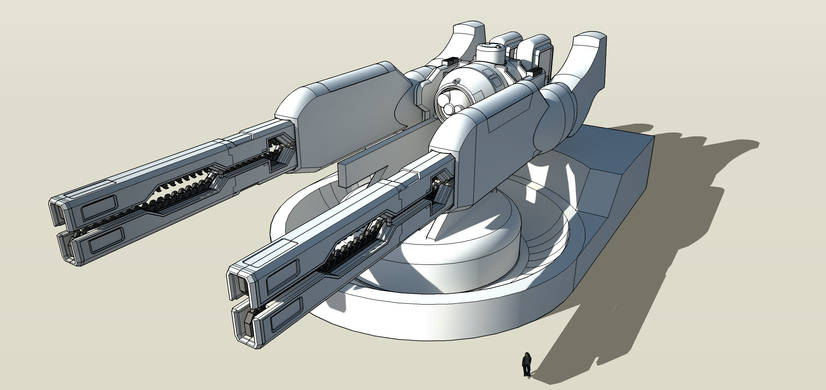Commodore Helix
Disintegrations done dirt cheap.

OUT OF CHARACTER INFORMATION
- Intent: To create a starship-borne weapon for Helix Solutions
- Image Source: Freiheitskampfer
- Canon Link: N/A
- Permissions: N/A
- Primary Source: N/A
- Manufacturer: Helix Solutions
- Affiliation: Helix Solutions
- Market Status: Closed-Market
- Model: HJH Heavensplit
- Modularity: No
- Production: Limited
- Material: Durasteel, Phrik, railgun components
- Classification: Railgun
- Size: Very Large
- Weight: Extremely Heavy
- Ammunition Type: Sabot Darts
- Ammunition Capacity: Very Large
- Effective Range: Extreme
- Rate of Fire: Low
- Damage Output: Extreme
- Recoil: Extreme
- Doubled barrel as standard to increase rate of fire
- Can be mounted on battlecruiser or larger ships, or emplaced on the ground to defend against orbital vessels
- Split the Heavens: Being the bigger, angrier, spaceborn brother of the Ironbreaker, the harm this weapon can inflict on an enemy vessel can only be described as catastrophic, relative to its weight class.
- Between the Eyes: The Heavensplit possesses a range and accuracy far in excess of that typically offered by turbolasers, able to reliably hit enemy vessels from vast distances, as well as being more viable against fast-moving targets in a pinch.
- Slow: Despite the default double-barreled design, this weapon suffers some of the rate of fire problems of its little brother, firing only once every several seconds.
- Power Glutton: Due to this weapon's intense power requirements, it can only feasibly be mounted on large, powerful vessels, and then only in rather modest numbers without beginning to compromise other systems.
- Vulnerable When Cooling: While normally fairly robust in construction, the weapon must vent a blast of flame and waste heat after every shot, during which time it partially opens up. During this period, it is highly vulnerable to damage.
The M3S railgun's range and deadliness did not go unnoticed by Helix command, and no sooner had it hit the field than there were already plans to cook up a shipboard version.
Possessing a maximum range approximately thrice that of most common turbolasers, and projecting a solid metal dart around the length of an average adult human (pictured for comparison), the so-called "Heavensplit" would typically see these projectiles fly at speeds in excess of 70000 kilometers per second, or a little more than one-fifth of the speed of light. Despite the fairly small projectiles used, the damage on an unshielded target can be extremely severe, and all but the mightiest shielding cannot long sustain repeat hits from one of these weapons. Still, this is not an ideal tool for precise orbital support under most circumstances, as unlike a turbolaser, the weapon's power cannot be easily scaled up or down, and the risk of hitting any engaged friendly ground targets in the considerable kill radius is deemed by most to be unacceptable. Therefore, Helix doctrine constrains these weapons to use in ship-to-ship combat in almost all circumstances.
For all their power, though, the draw on a reactor can best be understated as "prohibitive" and even when used as intended (fairly few, brief firings) users aboard a vessel or station bearing this weapon can expect lights to flicker at every discharge, unless the vessel is equipped with very significant power generation assets. Firing rates above factory standard can result in the failure of gravity or even life support systems, eventually causing permanent grid damage to the entire vessel. Smaller ships likely cannot spare the power required for proper operation at all, and only something of Battlecruiser size or larger could reasonably hope to mount and use one, let alone multiple.
Additionally, the weapon still carries over something of its little brother's slothful rate of fire, a downside its default double-barreled, alternating-shot design only partly mitigates. After each shot, the weapon opens up to vent a hail of blast-furnace temperature waste heat into the surrounding vacuum, a process taking a comfortable ten to fifteen seconds per barrel. During this period, opportunistic enemy bombers can pick the weapon out as a target, and damage or even destroy it. While it can in theory hit a moving fighter without needing to lead shots due to the sheer velocity of the ammunition, in practice this is a very poor weapon for point defense, perhaps even more so than a turbolaser.
Last edited:







